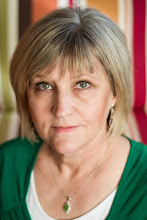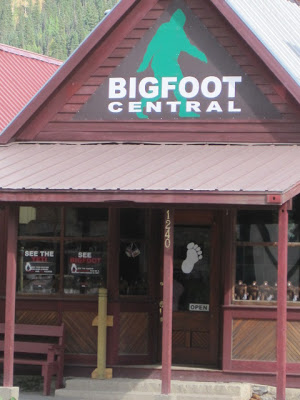Tuesday, September 28, 2010
Oktoberfest, Snowbird, Utah
I know that Oktoberfest is held all over, but this is a great spot. The alphorns are played on the top of Hidden Peak, which is a fabulous place. I loved it! Don't forget the German music and food.
Wednesday, September 22, 2010
Cliff Palace, Mesa Verde
Cliff Palace, the largest and most famous cliff dwelling in Mesa Verde National Park, has over 150 individual rooms and more than 20 kivas (rooms for religious rituals). Crafted of sandstone, wooden beams and mortar, Cliff Palace has been remarkably well preserved from the elements for the past 700 years.
Sunday, September 19, 2010
Liberty Bell, Philadelphia
The world's symbol for liberty... I have to say that I was totally unprepared for the emotional rush I had when I saw the liberty bell. Wow, it was a powerful experience.
Saturday, September 18, 2010
Haunted Ouray, Colorado
What could possibly be better that ghosts and books? That's what you'll find at Buckskin Booksellers. The store is located on main street, and has a chilling history. A young girl, Eller Day, was murdered here by a coworker at the adjoining Hotel Beaumont. The hotel was built in 1886. It was boarded up for 35 years, but restoration was begun on the hotel in 1964. During the time it was unused, people reported seeing the ghost of Eller and strange lights traveling from floor to floor of the hotel. The current owner of the bookstore has had some experiences of her own. She has heard knocking and banging from the back of the store and seen books come flying off of shelves. One day as two customers were checking out, three books flew off of the shelf behind them and positioned themself like this: book, customer, book, customer, book. No one was hit or hurt, but is was a startling experience. The unusual activity is more common in the winter months. The owner has also experienced the feeling that she was being watched when she was alone in the store.
Thursday, September 16, 2010
Silverton, Colorado
"Silverton: A gritty little mining town with Victorian pretensions!" Once the stomping ground of silver kings and railroad giants, Silverton survives today as one of Colorado's most endearing destinations.
The Silverton district opened legally to miners in 1874, following the Brunot Treaty with the Utes. An estimated 2000 men moved into the region that year. They came from across the U.S., many parts of Europe and even China, to endure severe winters and dangerous mining conditions in their pursuit of the minerals they hoped would make them rich.
Not all who settled were miners. By 1875 the 100 "sturdy souls" who lived in Silverton proper worked in the post office, sawmills, blacksmith shop, mercantile, newspaper, liquor stores, smelters, or assay office. The town's population grew to 500 by 1876. Life was not easy for any of them. Statistics from Silverton's cemetery note causes of death in early Silverton as 117 from snowslides, 143 from miner's consumption, 161 from pneumonia, 138 from influenza (most in the 1918 epidemic) and 202 from mine accidents.
It's just a little place, but fun for a stop in your drive through the mountains.
Monday, September 13, 2010
Balcony House, Mesa Verde, Colorado
Balcony House can only be visited with a ranger-led tour. This adventuresome tour allows you to experience a taste of what the orginal inhabitants experienced. Access is accomplished by ladders and stone steps carved into the cliff. Also, it is one of the few places where a dwelling has a preserved balcony.
Access to Balcony House is by a 32 foot ladder at the right end of the dwelling. Exiting the ruin is to the left, crawling behind a huge boulder, then climbing 60 feet up the cliff face on steps carved into the cliff and finally another ladder near the top. The tour is not for those who fear heights or tight places. The tight places didn't bother me, but I found heights bothered me more than I expected.
Balcony House is named for the remnants of a balcony on this building. Structures such as this balcony as well as roofs and upper floors were generally built with thin logs and branches covered by adobe. They deteriorated much more quickly than brick walls and are therefore rarely seen today.
The round objects in front of the buildings are remnants of kivas. They are chambers about eight feet deep and were originally covered over with an opening in the center for access. Kivas were thought to be community gathering places for religious ceremonies.
Friday, September 10, 2010
Between Ouray and Silverton, Colorado
The water was colorful to say the least, so I did a little research on it. Red Mountain Creek is an acid mine drainage stream in southwestern Colorado. It contains mining-related metals- concentrations of aluminum, cadmium, copper, lead, and zinc exceed chronic aquatic-life standards established by the State of Colorado. It also contains arsenic, iron, molybdenum, and vanadium. The minerals appear to be the result of surface inflows that have been affected by mining activities. All of that aside, the entire area is magnificent.








Tuesday, September 7, 2010
Bachelor Syracuse Mine (1884), Ouray, Colorado
The Bachelor-Syracuse Mine Tour takes you 1,800 feet horizontally into Gold Hill, rich in gold, silver, and other precious metals. You are accompanied by a thoroughly trained guide who has first-hand experience working the mine. The guide is prepared to answer questions and eager to share the legend and lore of the mine. You will see the equipment used in mining, the rich silver veins, and other mineral deposits. The stopes, declines, crosscuts, run-a-rounds and drifts are explained. You visit the work areas and see how explosives are used (even though there are no explosives underground currently.)
Monday, September 6, 2010
Ute Indian Museum, Montrose, Colorado
The Ute Museum sits in the heart of traditional Ute territory on lands once homesteaded by Chief Ouray. Migrating from the mountains in the summer to river valleys in the winter, the Utes used the abundant plants and animals of the Uncompahgre River valley for food, clothing, and shelter.
The museum lies on the original 8.65-acre homestead owned by Chief Ouray and his wife, Chipeta. Built in 1956 and expanded in 1998, the museum offers one of the most complete collections of the Ute people. The grounds include the Chief Ouray Memorial
Park, Chipeta's Crypt, and a native plant garden.
Just by luck, we happened to be at the Ute Museum on Chipeta Day, a cultural happening for the entire community of Montrose. Chipeta Day started in 2002 to remember, honor, and respect Chipeta, wife of Chief Ouray. Chipeta died in 1924, and was brought back home to Montrose in March 1925. At that time, only two Indian people attended her funeral. The three Ute tribes came together on traditional Ute lands to honor and remember Chipeta.
Saturday, September 4, 2010
Christ of the Mines, Colorado
This shrine, located on the mountain just on the outskirts of Silverton, was built to ask for Christ's blessings on the mining industry of the San Jaun in 1958. A plaque of thanksgiving to Christ of the Mines was placed on the shrine for the deliverance of the entire workforce in 1978 when Lake Emma flooded the Sunnyside Mine. People have written little prayers to Jesus and put them in a box at the shrine. The notes were very touching, as was the act of faith that inspired the building of the shrine. I loved it!
Thursday, September 2, 2010
Old South Meeting House, Boston
The Old South Meeting House was built in 1729 as a Puritan house of worship. It was also the largest building in colonial Boston.The Old South Meeting House is best known as the site of where the Boston Tea Party began. In the winter of 1773, more than 5,000 colonists gathered at Old South in a meeting to protest the tax on tea. After many hours of debate, Samuel Adams announced, "This meeting can do nothing more to save the country!" Protestors stormed out of the Old South Meeting House to the waterfront where they dumped three shiploads of tea into Boston Harbor. They changed American history forever.
Subscribe to:
Posts (Atom)


































